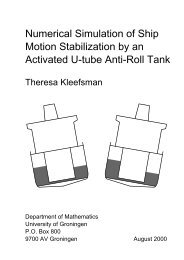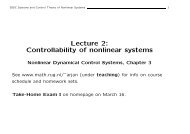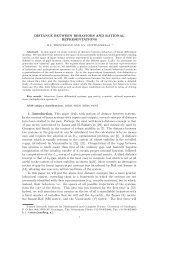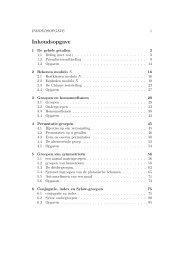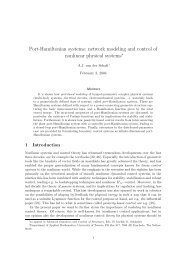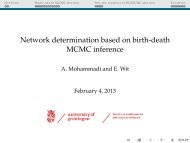Chaos and quasi-periodicity in diffeomorphisms of the solid torus
Chaos and quasi-periodicity in diffeomorphisms of the solid torus
Chaos and quasi-periodicity in diffeomorphisms of the solid torus
Create successful ePaper yourself
Turn your PDF publications into a flip-book with our unique Google optimized e-Paper software.
y [24, Theorem III.6.3] <strong>the</strong> map Q a ∗ is Collet-Eckmann (see e.g. [24, Section V.4]), that is,<br />
<strong>the</strong>re exist constants κ > 0 <strong>and</strong> λ > 1 such that<br />
∣ d<br />
∣∣∣<br />
∣dx a ∗(Q a ∗(c)) ≥ κλ n for all n ≥ 0. (22)<br />
Therefore, by comb<strong>in</strong><strong>in</strong>g [38, Theorem 3] with <strong>the</strong> Collet-Eckmann condition (22) we get<br />
lim<br />
n→∞<br />
d<br />
da Qn a (c) | a=a ∗<br />
d<br />
dx Qn−1 a ∗ (Q a<br />
∗(c))<br />
> 0. (23)<br />
Assume Q k a ∗(c) = p, with p periodic (<strong>and</strong> repell<strong>in</strong>g) under Q a∗. By p(a) denote <strong>the</strong> cont<strong>in</strong>uation<br />
<strong>of</strong> p for a close to a ∗ . Then, for all n sufficiently large,<br />
d<br />
da Qn a (c) | a=a ∗ = ∂Qn−k a<br />
∂a<br />
= ∂<br />
∂a Qn−k a<br />
= d da<br />
(Qk a ∗(c)) | a=a ∗ +∂Qn−k a<br />
∂x (Qk a ∗(c)) | d<br />
a=a ∗<br />
(p) | a=a ∗ + ∂<br />
d<br />
(p) | a=a ∗<br />
(<br />
Q<br />
n−k<br />
a (p(a)) ) + ∂<br />
∂x Qn−k a<br />
∂x Qn−k a ∗<br />
da Qk a (c) | a=a ∗=<br />
[<br />
p(a) + Q<br />
k<br />
da<br />
a (c) − p(a) ] | a=a ∗=<br />
(p) d [<br />
Q<br />
k<br />
da a (c) − p(a) ] | a=a ∗ .<br />
(24)<br />
The po<strong>in</strong>t Qa<br />
n−k (p(a)) belongs to a hyperbolic periodic orbit, that varies smoothly with <strong>the</strong><br />
parameter a. Therefore, its derivative with respect to a (which is <strong>the</strong> first term <strong>in</strong> <strong>the</strong> last<br />
equality) is uniformly bounded <strong>in</strong> n. On <strong>the</strong> o<strong>the</strong>r h<strong>and</strong>,<br />
d<br />
dx Qn−1 a ∗<br />
(Q a ∗(c)) = ∂<br />
∂x Qn−k a ∗<br />
(p) d<br />
dx Qk−1 a ∗<br />
(Q a ∗(c)).<br />
Therefore, by (22), (23), <strong>and</strong> (24) we conclude that<br />
d<br />
da<br />
0 < lim<br />
Qn a (c) | [<br />
d<br />
a=a ∗<br />
n→∞ d<br />
dx Qn−1 a (Q ∗ a ∗(c)) = da Q<br />
k<br />
a (c) − p(a) ] a=a ∗<br />
d<br />
dx Qk−1 a (Q ∗ a ∗(c)) . (25)<br />
This proves that Q a satisfies condition 6 <strong>of</strong> Def<strong>in</strong>ition 4.<br />
We now show that <strong>the</strong> n-th iterate M a <strong>of</strong> <strong>the</strong> quadratic map is a d-family for all n > 1<br />
<strong>and</strong> for some d ≤ 2 n . For simplicity, we denote Q a ∗ by Q for <strong>the</strong> rest <strong>of</strong> this pro<strong>of</strong>. Condition<br />
1 holds for M a ∗ s<strong>in</strong>ce it holds for Q a ∗. Condition 3 follows from <strong>the</strong> fact that <strong>the</strong> composition<br />
<strong>of</strong> maps with negative Schwarzian derivative also has negative Schwarzian derivative, see<br />
e.g. [24, II.6]. Condition 4 is obviously satisfied.<br />
Condition 2 is now proved by <strong>in</strong>duction on n, where <strong>the</strong> case n = 1 is obvious. Obviously,<br />
<strong>the</strong> set Cr M a ∗ <strong>of</strong> critical po<strong>in</strong>ts <strong>of</strong> M a ∗ has card<strong>in</strong>ality d ≤ 2 n − 1. Moreover,<br />
Cr M a ∗ = Q ( −1 Cr Q n−1) n−1<br />
⋃<br />
∪ Cr Q = (Q −j )(Cr Q). (26)<br />
Suppose that condition 2 holds for a given n ≥ 1. We first show that<br />
j=0<br />
(Q n+1 ) ′′ (x) ≠ 0 for all x ∈ Cr Q n+1 . (27)<br />
By (26), if x ∈ Cr Q n+1 <strong>the</strong>n ei<strong>the</strong>r x = c, or Q(x) ∈ Cr Q n . If x = c <strong>the</strong>n<br />
(Q n+1 ) ′′ (x) = (Q n ) ′ (Q(c)) · (Q) ′′ (c). (28)<br />
22




